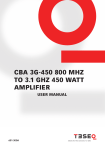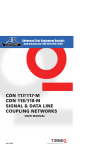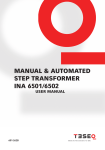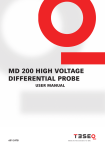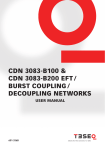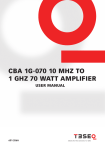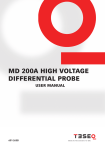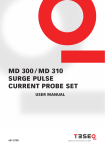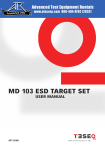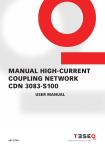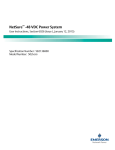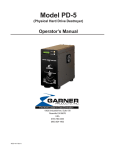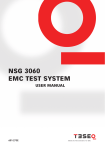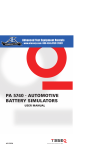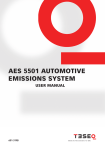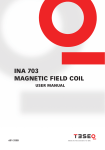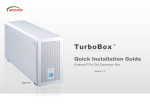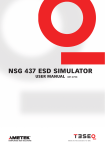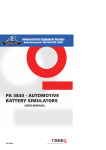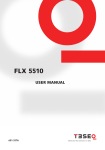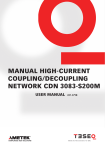Download 601-294A - CBA 100M-1100 User Manual english.indd
Transcript
1 cBA 100M-1100 10 KHZ to 100 MhZ 1.1 KW amplifier user Manual 601-294A cBA 100M-1100 10 KHZ to 100 MhZ 1.1 KW amplifier USER Manual CBA 100M-1100 User Manual contentS 1 Safety information 2Introduction 2.1 CBA 100M-1100 Introduction 3 Unpacking and installation 3.1Unpacking 3.2Installation 4Operation 5 Specifications 6Warranty 7Adresses 5 7 7 9 9 9 12 16 18 20 1Safety Information This apparatus has been designed and tested in accordance with BS EN 61010-1, and has been supplied in a safe condition. This manual contains some information warnings which must be followed to ensure safe operation, and to retain the apparatus in a safe condition. This apparatus does not incorporate components liable to explode or implode during normal operating conditions. In normal operating conditions this apparatus does not liberate injurious or poisonous gases. Sound levels of this apparatus after installation in a rack are below 85 dBA, as required by EN 61010-1. However local regulations may have a lower limit or the system as a whole may exceed the local limit. In this case appropriate action should be taken, ie of use of any protective equipment required by local regulations. This apparatus is of installation category 2. 5 6 This apparatus is capable of delivering harmful levels of radio frequency power. Ensure at all times during operation that the RF output is properly terminated with an adequately rated termination or transducer, and that the cables and connectors attached to the apparatus are in good condition. The mains plug shall only be inserted in a socket outlet provided with a protective earth contact. The protective action must not be negated by the use of an extension cord without a protective conductor. The opening of covers or removal of parts is likely to expose live parts. This apparatus must be disconnected from all voltage sources before it is opened for adjustment, replacement, maintenance or repair. Make sure that only fuses of the required rated current and of the specified type are used for replacement. The use of makeshift fuses and the short-circuiting of fuse holders is prohibited. CBA 100M-1100 User Manual 2Introduction CBA 100M-1100 Introduction The CBA 100M-1100 is an amplifier capable of supplying 1.1 kW into a 50 ohm load over the frequency range 10 kHz to 100 MHz, during the course of EMC tests on electrical equipment. The amplifier is designed with sufficient gain such that it may be used with normal output levels of signal sources. A safety interlock on the rear panel is also provided, which will mute the amplifier when grounded. The unit is powered from a switched mode power supply for high efficiency, high power factor and wide voltage range operation. The unit is air cooled with integral fans, and is protected against faulty cooling by excess temperature sensing. A front panel indicator is provided to indicate over-temperature. The amplifier is designed for rugged operation into a variety of loads. The amplifier is primarily intended for use as a power source for EMC susceptibility testing, but is also applicable to other systems requiring a wide-band linear amplifier. This amplifier is designated as ‘professional equipment’ and should not be operated by untrained staff. As this product has the capability to generate high levels of RF energy it is not intended for use in a residential environment. Potential or theoretical hazards. 7 8 Threat Precaution Exposure of personnel to high RF fields Ensure that the antenna is inside a produced by an antenna connected to screened enclosure and fit an interlock the output of the amplifier. to the entry door to prevent access while the amplifier is operating. RF burns caused by contact with the Ensure that the antenna is inside a antenna connected to the output of screened enclosure and fit an interlock the amplifier. to the entry door to prevent access while the amplifier is operating. Amplifier self oscillation caused by This is an unlikely but theoretical feedback from un-terminated con- possibility. Always ensure that the amplifier input is terminated either nectors. by the system signal generator or by a suitable RF load/attenuator before switching the amplifier on. Arcing due to high RF voltages present Always ensure that the output of the at the output connector. amplifier is terminated either by the system antenna or a suitable high power RF load or attenuator. CBA 100M-1100 User Manual 3Unpacking and installation 3.1 Unpacking The CBA 100M-1100 should contain the following items housed in a 19 inch 34 U rack: Amplifier switch unit Amplifier module Amplifier input/output module Amplifier power unit 1 4 1 1 Plus the following documentation: CBA 100M-1100 Operating manual (this document) Certificate of calibration 1 1 Check that the equipment is complete as in the packing list above. If any signs of damage are found inform Teseq and do not install or use the instrument. If the shipping carton has been damaged, retain the shipping carton and packing material for the inspection by the carrier. 3.2 Installation This instrument must be earthed. 9 10 If supplied with 3-phase mains in star connection, a neutral line must be supplied. In delta configuration, no neutral is required. This equipment is intended for rack mounting, using suitable tray and runners etc. The individual modules must not be mounted only by the front panels. Typically, the amplifier will be supplied ready assembled in a cabinet. However, if supplied in separate units for shipping convenience, the assembly procedure is as below. Arrangement of modules in cabinet. This amplifier is supplied with a 34 U instrument rack ready for the insertion of the modules. The modules should be arranged with the power unit at the bottom, then two amplifier units, then the amplifier input/output unit, then two further amplifier units, and finally the amplifier switch unit. The amplifier units are distinguished only by the length of DC supply cable, and so should be ordered from bottom to top such that the unit with the shortest supply cable is at the bottom, and the unit with the longest supply cable is at the top. For convenience and ease of assembly, a 1U spacer panel is supplied for insertion between each unit. Cable connection Connect the centre unit supply cable from the power unit to the centre unit. Connect each of the amplifier modules to the power unit using the connectors and cables supplied. Connect the SMA to SMA RF cables from each of the outputs on the centre unit, to the connectors on each of the amplifier units, and similarly for the N to N cables The order of connection is arbitrary. Connect the BNC to BNC cables from the centre unit to each of the amplifier units. CBA 100M-1100 User Manual Mains input is via a pre-wired IEC 60309 3-phase plug. Star configured supplied with a 5 pin plug. Delta configured supplied with a 4 pin plug If the plug requires rewiring, brown and 2 black wires are 3-phase line, blue is neutral when used in star (unused in delta configuration) and green/yellow for earth. The amplifier safety mechanism is a circuit breaker. The switch unit is supplied from the power unit via the power breaker, located on the rear panel of the power unit. Connect the cable from the switch unit to the power unit 7 pin socket. The remaining connectors are: RF input, RF output and BNC interlock. The use of the interlock is optional, and the amplifier will operate normally with this connector left unterminated. If an attachment is made to the BNC interlock, ensure that the connector is a 50 ohm type and that a high quality coaxial cable is used for connection to the switch. Make sure that the amplifier is located in a situation with adequate ventilation. During operation, the amplifier will draw as much as 6 kVA from the mains. Ensure that the environment of the amplifier does not cause warm air from the fans to be cycled back into the amplifier. 11 12 4Operation Mains switch (on amplifier switch unit) Operating the mains switch located on the rear of the power supply unit will apply power to the system. The amplifier can now be switched on and off using the push button located on the front panel. Power indicator (on amplifier centre unit) This indicator will illuminate when the mains switch is turned on, and power is available from the mains. Indicators are also fitted to the power unit and amplifier units. Safety interlock indicator (on amplifier centre unit) With a short circuit applied to the safety interlock connector on the rear panel, this indicator will illuminate and the amplifier gain stages will all be turned off. The fans will continue to operate. A short circuit applied to this connector also functions as a fault reset (see entry under “Fault Indicator”). Fault indicator (on amplifier centre unit) The amplifier protects itself from the following faults: Excess module temperature Air cooling failure (through faulty fan or blocked vent) Partial power supply failure (loss of phase or PSU failure) In the case of one of these faults occurring the fans will continue to operate. The fault state is indicated by the illumination of the red fault indicator. The behaviour of the amplifier under these circumstances provides a first level diagnostic to the fault, as described in table 1. CBA 100M-1100 User Manual 13 Symptom Possible cause Course of action Fault light illuminates immediately Excess module temperature Let amplifier fans run for a while, and re-try later Air-cooling failure Check fan operation and air vents Power supply failure Check mains supply for interruption Excess module temperature Check ambient temperature of amplifier environment Amplifier runs for a while and then goes into fault mode Table 1. Fault diagnosis after interlock cycling operation If the actions indicated in table 1 are not successful in restoring correct operation, then contact Teseq technical support. The fault indicator will not illuminate if the amplifier is placed in the interlock state. 14 RF input (rear panel of centre unit) The RF input will accept a signal from an RF generator. This input must be within the operating frequency range of 10 kHz to 100 MHz. An amplitude of up to 0 dBm will be sufficient to saturate the amplifier. Operation outside the specified frequency range should not be attempted, and may subject the amplifier to undue internal stress. RF output (rear panel of centre unit) This connector must be suitably terminated at all times during operation. Ensure that the external N type connector, 50 ohm co-axial cable and load are all capable of handling the power available, which can exceed 1 kW. Do not operate the amplifier without a proper termination or with defective cables or connectors. The centre conductor of the RF output represents a severe burn hazard to personnel. Do not remove the output connector during operation, as a self-sustaining arc may be struck, which will damage the output connector, and create a fire hazard. Air inlets The amplifier units, input/output unit a power unit all depend upon a free air supply for cooling. Ensure that the front air inlets are not restricted. Note Dust can rapidly build up on the air inlets, these should be checked and cleaned at regular intervals to ensure continued reliable operation of the amplifier. Intervals should not be longer than six months but may be required more often in dusty environments. CBA 100M-1100 User Manual Mains input Mains input is via a pre-wired IEC 60309 3-phase plug. Star configured supplied with a 5 pin plug. Delta configured supplied with a 4 pin plug. If the plug requires rewiring brown and 2 black wires are 3-phase line, blue is neutral when used in star (unused in delta configuration) and green/yellow for earth. The amplifier safety mechanism is a circuit breaker. The switch unit is supplied from the power unit via the power breaker, located on the rear panel of the power unit. Safety interlock This connector may be left open-circuit if no safety interlock is required, or other safety methods are in place. The amplifier will operate satisfactorily. To operate the safety interlock, short-circuit this connector. Current drawn from this connector under short circuit conditions will typically be 2.8 mA. Air outlets The air outlets for the amplifier must have unrestricted access for proper operation. Do not place the back of the amplifier less than one metre from a wall or other obstruction. 15 16 5Specification The following specification applies over the operational temperature and frequency range unless otherwise stated, and does not include the characteristics of connecting cables. Frequency range (instantaneous) Rated output power Output power at 1 dB gain compression Gain Third order intercept point Gain variation with frequency Harmonics at 1000 W output Output impedance Stability Output VSWR tolerance Input VSWR RF connector style Safety interlock USB interface 0.01-100 MHz 1100 W minimum 1000 W minimum 62 dB 72 dBm ±3 dB Better than -20 dBc 50 Ω Unconditional Infinity:1 2:1 Type N female females/c to mute Optional EMC and safety Conducted and radiated emissions Conducted and radiated immunity Mains harmonic currents Voltage fluctuations and flicker Safety EN 61326 class A EN 61326: 1997 table 1 EN 61000-3-2 EN 61000-3-3 EN 61010-1 CBA 100M-1100 User Manual Power Supply voltage (3-phase) Supply frequency range Supply power Mains connector 184-264 Vac 47-63 Hz <6 KVA Appropriate IEC 60309 plug (see options) Environmental Operating temperature range 0 to 40°C Mechanical Dimensions Mass 19 inch, 34U rack, 800 mm deep 200 kg 17 Options (select at time of ordering) 341-721 3-phase plus P.E. Delta connection no neutral (4 pin plug) 341-722 3-phase, neutral puls P.E. Star connection (5 pin plug) Notes 1 The third order intercept point is a nominal value, as its calculation depends upon the power level at which distortion measurements are made. 2 Output VSWR tolerance is specified for excitation within the permitted levels and frequency range. 18 6Warranty Hardware Teseq Limited (the company) warrants its amplifiers to be free from defects in workmanship and materials, under normal use and service, for three years from the date of purchase from the company or its authorised agent. If a product does not operate as warranted during the warranty period, the company shall, at its option, repair the defective product or part, deliver an equivalent product or part to replace the defective item, or refund the purchase price paid for the defective product. Transportation of the defective product or part to the factory or service centre is to be pre-paid by the customer. All products that are replaced will become the property of the company. Any replaced or repaired product or part has a ninety (90) day warranty or the remainder of the initial warranty period, whichever is longer. All information in this manual is given in good faith. However, the company shall not be liable for any loss or damage whatsoever arising from the use of this manual, the product described in it or any errors or omissions in either. CBA 100M-1100 User Manual NOTES 19 20 Headquarters Teseq AG 4542 Luterbach, Switzerland T + 41 32 681 40 40 F + 41 32 681 40 48 sales @ teseq.com www.teseq.com Manufacturer Teseq AG 4542 Luterbach, Switzerland T + 41 32 681 40 40 F + 41 32 681 40 48 sales @ teseq.com China Teseq Company Limited T + 86 10 8460 8080 F + 86 10 8460 8078 chinasales @ teseq.com France Teseq Sarl T + 33 1 39 47 42 21 F + 33 1 39 47 40 92 francesales @ teseq.com Germany Teseq GmbH T + 49 30 5659 8835 F + 49 30 5659 8834 desales @ teseq.com Japan Teseq K.K. T + 81 3 5725 9460 F + 81 3 5725 9461 japansales @t eseq.com Singapore Teseq Pte Ltd. T + 65 6846 2488 F + 65 6841 4282 singaporesales @ teseq.com Switzerland Teseq AG T + 41 32 681 40 50 F + 41 32 681 40 48 sales @ teseq.com Taiwan Teseq Ltd. T + 886 2 2917 8080 F + 886 2 2917 2626 taiwansales @ teseq.com UK Teseq Ltd. T + 44 845 074 0660 F + 44 845 074 0656 uksales @ teseq.com USA Teseq Inc. T + 1 732 417 0501 F + 1 732 417 0511 Toll free +1 888 417 0501 usasales @ teseq.com © December 2010 Teseq® Specifications subject to change without notice. Teseq® is an ISOregistered company. Its products are designed and manufactured under the strict quality and environmental requirements of the ISO 9001. This To find your local partner within document has been carefully checked. Teseq®’s global network, please go to However, Teseq® does not assume www.teseq.com any liability for errors or inaccuracies.




















